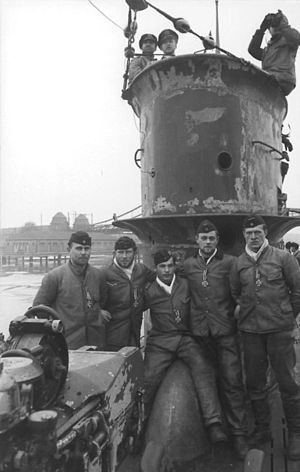Name U-50 Laid down 3 November 1938 Construction started 3 November 1938 Length 66 m Beam 6.2 m | Ordered 21 November 1936 Yard number 585 Commissioned 12 December 1939 Launched 1 November 1939 Draft 4.74 m | |
 | ||
Builder | ||
German submarine U-50 was a Type VIIB U-boat of Nazi Germany's Kriegsmarine during World War II. Ordered on 21 November 1936, she was laid down as yard number 585 at the yards of Friedrich Krupp Germaniawerft AG in Kiel on 3 November 1938. She was launched on 1 November 1939 and commissioned on 12 December 1939 by Kapitänleutnant (Kptlt.) Max-Hermann Bauer, who was the sole commander of the boat. In her short career she conducted only two patrols, both as part of the 7th U-boat Flotilla. In this time she succeeded in sinking four ships, totalling 16,089 gross register tons (GRT).
Contents
Design
German Type VIIB submarines were preceded by the shorter Type VIIA submarines. U-50 had a displacement of 753 tonnes (741 long tons) when at the surface and 857 tonnes (843 long tons) while submerged. She had a total length of 66.50 m (218 ft 2 in), a pressure hull length of 48.80 m (160 ft 1 in), a beam of 6.20 m (20 ft 4 in), a height of 9.50 m (31 ft 2 in), and a draught of 4.74 m (15 ft 7 in). The submarine was powered by two Germaniawerft F46 four-stroke, six-cylinder supercharged diesel engines producing a total of 2,800 to 3,200 metric horsepower (2,060 to 2,350 kW; 2,760 to 3,160 shp) for use while surfaced, two AEG GU 460/8-276 double-acting electric motors producing a total of 750 metric horsepower (550 kW; 740 shp) for use while submerged. She had two shafts and two 1.23 m (4 ft) propellers. The boat was capable of operating at depths of up to 230 metres (750 ft).
The submarine had a maximum surface speed of 17.9 knots (33.2 km/h; 20.6 mph) and a maximum submerged speed of 8 knots (15 km/h; 9.2 mph). When submerged, the boat could operate for 90 nautical miles (170 km; 100 mi) at 4 knots (7.4 km/h; 4.6 mph); when surfaced, she could travel 8,700 nautical miles (16,100 km; 10,000 mi) at 10 knots (19 km/h; 12 mph). U-50 was fitted with five 53.3 cm (21 in) torpedo tubes (four fitted at the bow and one at the stern), fourteen torpedoes, one 8.8 cm (3.46 in) SK C/35 naval gun, 220 rounds, and one 2 cm (0.79 in) anti-aircraft gun The boat had a complement of between forty-four and sixty.
First patrol
Departing the German-administered island of Helgoland (sometimes known as Heligoland), on 6 February 1940, U-50 proceeded north of the British Isles. It was here that she sighted her first victim at 22.40 hours on 11 February. The neutral Swedish steam merchant ship Orania (1,854 GRT) was homeward bound from Argentina with a load of maize, bran and oil cakes. Despite running fully illuminated, the U-Boat was unable to identify her as neutral but attacked with a single torpedo at 23.54 hours about 65 miles north-northeast of the Shetland Islands. All 24 souls aboard abandoned ship in two lifeboats, but one, with fourteen occupants, was never seen again. The remaining ten survivors were picked up the next day by HMS Faulknor, transferred to HMS Foxhound, and landed at Lerwick in Scotland.
In the early morning hours of 15 February, U-50 crossed paths with her second victim, the 4,895 GRT Danish steam merchantman Maryland, which was travelling unescorted. The first torpedo, fired at 01.54 hours, detonated prematurely (a common problem early in the war). A second shot at 02.07 hours broke the ship's back and she sank in seven minutes. All 34 aboard perished; only a wrecked lifeboat was found later, at North Uist.
U-50 travelled south after this encounter and found her third victim, the neutral Dutch steam merchant ship Tara (4,760 GRT) west of Cape Finisterre. Despite her neutral affiliation, she was travelling without neutrality markings (according to the U-Boat captain's log). The submarine had spotted her at midnight and attacked with a single torpedo at 01.38 hours, which missed. A second torpedo at 02.54 hours found its mark. All hands abandoned ship in two lifeboats as U-50 moved in to deliver the coup de grâce at 03.12 hours. The vessel sank twenty minutes later. One lifeboat made landfall on the Spanish coast. The other was picked up by the Spanish fishing trawler Milin; its occupants were landed at A Coruña.
At 00.20 hours on 22 February, U-50 located convoy OGF-19 and torpedoed the 4,580 GRT British tanker British Endeavour about 100 miles west of Vigo. Five were killed in the attack, the remaining thirty-three (including the ship's master), abandoned ship and were picked up by the British merchantman Bodnant. The survivors were landed at Funchal in Portugal on 26 February.
The U-Boat terminated this successful patrol at Kiel on 4 March after 28 days at sea.
Second patrol
U-50's second and final patrol began 5 April 1940. She departed Kiel and was never heard from again.
Fate
U-50 ran afoul of a minefield and sank on 6 April in the North Sea north of Terschelling. Her exact position is not known. All 44 sailors were killed.
Mines laid by the Allied destroyers HMS Express, Esk, Icarus, and Impulsive in the North Sea on 3 March 1940, were probably responsible for the destruction of U-50 as well as several other U-boats as they returned to port.
